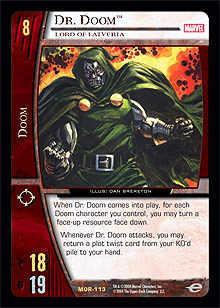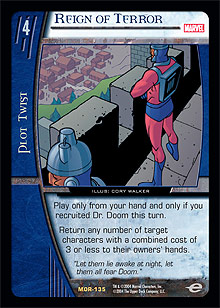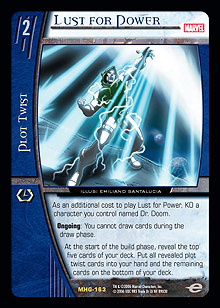 I’ve been working for Vs. System R&D for over two years, and since my first day here, Dr. Doom (and his minions) has played an important role in my work. See, we have several cabinets full of decks in our office, broken down by various sets and eras. If you go back to the first shelf full of our earliest decks, you get some real doozies. Somewhere, probably wedged between a Fearsome Five / X-Men deck and about twenty different “Spider-Man 7 / random other team” team-up decks, is a Doom / New Gods team-up deck that tried to use Takion to ramp up to a turn 7 Dr. Doom, Lord of Latveria. It was designed (appropriately enough) by Heralds lead designer Andrew Yip and remains my favorite in-office deck. Sure, I never won a game with it (or put an additional resource into play with Takion, come to think of it), but the power and excitement of Doom, Mystical Paralysis, and all the others remain my most enduring memory of early Vs. play.
I’ve been working for Vs. System R&D for over two years, and since my first day here, Dr. Doom (and his minions) has played an important role in my work. See, we have several cabinets full of decks in our office, broken down by various sets and eras. If you go back to the first shelf full of our earliest decks, you get some real doozies. Somewhere, probably wedged between a Fearsome Five / X-Men deck and about twenty different “Spider-Man 7 / random other team” team-up decks, is a Doom / New Gods team-up deck that tried to use Takion to ramp up to a turn 7 Dr. Doom, Lord of Latveria. It was designed (appropriately enough) by Heralds lead designer Andrew Yip and remains my favorite in-office deck. Sure, I never won a game with it (or put an additional resource into play with Takion, come to think of it), but the power and excitement of Doom, Mystical Paralysis, and all the others remain my most enduring memory of early Vs. play.
I’m sure that many longtime Vs. players share those same memories (minus the Takion, I’d imagine), so I was very excited that we would be re-featuring Doom. Of course, the re-introduction of Doom caused some concern across the office. It wasn’t just that we were bringing back a powerful team, which we had done successfully with Brotherhood; Doom was going to be harder. While Brotherhood remains one of our most iconic beatdown teams, it’s a bit of a dinosaur by current standards. That isn’t to say that Brotherhood is overly weak or underpowered, but rather that many of our modern off-curve decks are doing things at least as powerful as what Brotherhood does. The New Brotherhood and Savage Land are pretty impressive ATK modifiers, but are they really that much better (if at all) than Faces of Evil? In terms of off-curve enabling, Brotherhood has nothing on the level of Yellowjacket or Beetle. In fact, when we re-featured Brotherhood, we were able to push the envelope on their low cost characters (something we previously thought we would need to under-power to keep their decks in check) without throwing things out of whack in Golden Age.
 Doom, on the other hand, is no dinosaur. Mystical Paralysis and Reign of Terror remain two of the best cards in the game, ever. Dr. Doom, Diabolic Genius is probably the best defensive 4-drop in the game, and Boris is one of the best plot twist searchers. No matter what the shifts of Golden Age—from quick wins involving Rigged Elections to infinitely long X-Stall matches—Doom has always been at the forefront of the format. Doom had been kept in check by the underwhelming nature of the rest of the Doom cards; the team doesn’t have very much action after its top tier cards, especially among the early drops. Thus, development had their basic assignment: make exciting cards for Doom that aren’t better than their most powerful cards and also don’t shore up all of the weaknesses on the team. We’ve had easier tasks.
Doom, on the other hand, is no dinosaur. Mystical Paralysis and Reign of Terror remain two of the best cards in the game, ever. Dr. Doom, Diabolic Genius is probably the best defensive 4-drop in the game, and Boris is one of the best plot twist searchers. No matter what the shifts of Golden Age—from quick wins involving Rigged Elections to infinitely long X-Stall matches—Doom has always been at the forefront of the format. Doom had been kept in check by the underwhelming nature of the rest of the Doom cards; the team doesn’t have very much action after its top tier cards, especially among the early drops. Thus, development had their basic assignment: make exciting cards for Doom that aren’t better than their most powerful cards and also don’t shore up all of the weaknesses on the team. We’ve had easier tasks.
Of course, the basic direction of the team made this a bit easier. While Doom had precedent in terms of Army characters (go back to Origins and check out all of his ’bots, if you don’t believe me), clearly his robots were never a primary part of a high-level deck. (My apologies to Craig Krempels, who played a ton of Doom-Bots to a Top 8 finish at the first Pro Circuit.) While we could just make a slew of powerful Army cards that wouldn’t work with the classic Doom decks, we felt that would be a huge disappointment to the Doom enthusiasts expecting some exciting legacy content. While Army cards would certainly comprise the majority of the Doom team’s new additions, we needed to make a healthy number of cards that looked like older Doom cards and were exciting to old Doom players. And again, we had to do this with the constraints I described above. Development (along with design) came up with some interesting solutions to make the whole thing come together.
1. There can be only one
Early in development, the power currently on Dr. Doom, Richards’s Rival was on a different character. This was pretty worrisome, since beyond being extremely potent, this card made it very difficult to miss Reign of Terror on turn 4 and very easy to double up on it if desired. At the same time, it was pretty cool and spoke to Doom’s old plot twist theme. We wanted to keep the card around, but we weren’t comfortable with its interactions with old Doom cards. The solution? Make it into a Dr. Doom. Now anyone wanting to exploit that curve would either have to pay a huge cost (replacing his or her 3-drop on turn 4) or go through some effort to make Dr. Doom non-unique. Dr. Doom, Sorcerous Savant received a similar treatment. Not only does this make thematic sense (the best characters with the Doom affiliation are the Dr. Dooms themselves), but it also allowed us to make a lot of splashy characters without making the old Doom deck out of control.
2. Point players in new directions
Doom’s best decks have traditionally been stall decks that ignored the earlier stages of the game. Part of what we did was create cards similar to Origins Doom cards, but design them in such a way that they required a new play pattern to be effective. Mask of Doom looks very similar to Faces of Doom, except it requires an early character to be useable. The new Doomstadt, Castle Doom clearly directs players to try to build a more aggressive style of Doom deck. The Devil We Know is pretty powerful once you ensure that your characters will be stunning back, which again directs the player somewhere else. Dr. Doom, Sorcerous Savant looks a lot like Diabolic Genius, but encourages you to play a lot of cheap characters. In this sense, they aren’t as divergent as cards referencing Army (all of the above cards are perfectly serviceable in an old Doom deck), but the cards are clearly maximized when a player deviates from the traditional builds and takes the deck in a different direction.
3. Look to expand into other effects
 Reign of Terror and Mystical Paralysis play on a different level than other cards. We could have tried to make a new version of either of them, but they would have likely fallen so short of the originals that they wouldn’t have been exciting or splashy at all. So, instead of trying to find ways to make similar versions of these cards, we looked toward powerful, unique effects that hadn’t been seen on teams before. Remember that Doom has always been about plot twists more than anything else, and there is a pretty wide range of what plot twists can do. Time Thief gives Doom (and Kang, I suppose) a way of destroying decks that lean too heavily on a single card or on search effects in general. Lust for Power is a card straight out of a Michael Barnes article that can net a whole heap of cards. Armies of Doom is like a Hard Sound Construct, except it can get back a character that says, “Ready Dr. Doom.” What none of these cards are, though, are natural or obvious fits into a classic Doom deck. I expect all of these cards (and others on the team) to make an impact across all formats, but I don’t expect anyone to just stick them into their old Doom deck and run with it.
Reign of Terror and Mystical Paralysis play on a different level than other cards. We could have tried to make a new version of either of them, but they would have likely fallen so short of the originals that they wouldn’t have been exciting or splashy at all. So, instead of trying to find ways to make similar versions of these cards, we looked toward powerful, unique effects that hadn’t been seen on teams before. Remember that Doom has always been about plot twists more than anything else, and there is a pretty wide range of what plot twists can do. Time Thief gives Doom (and Kang, I suppose) a way of destroying decks that lean too heavily on a single card or on search effects in general. Lust for Power is a card straight out of a Michael Barnes article that can net a whole heap of cards. Armies of Doom is like a Hard Sound Construct, except it can get back a character that says, “Ready Dr. Doom.” What none of these cards are, though, are natural or obvious fits into a classic Doom deck. I expect all of these cards (and others on the team) to make an impact across all formats, but I don’t expect anyone to just stick them into their old Doom deck and run with it.
The re-featuring of Dr. Doom was one of the greatest challenges ever given to R&D. Although there were many difficulties and issues with bringing back such a powerful team, in the end I think we did an excellent job. What I am most proud of is that there aren’t any cards that “just go” into old Doom decks. While there are plenty of cards that push the envelope in terms of power, we didn’t make it easy on our players to put them into decks. I’m very pleased with the challenges that Doom is going to present to deckbuilders, and I expect innovative decks and synergies involving the new Doom cards for years to come.
Tune in next week as Antonino DeRosa discusses the development of off-curve hate, or “How many Mikado and Moshas does Dave Humpherys put into his deck when he knows he’s testing against Patrick Sullivan?”